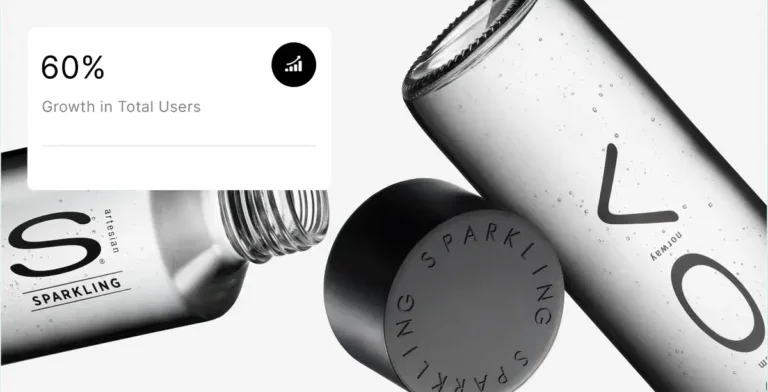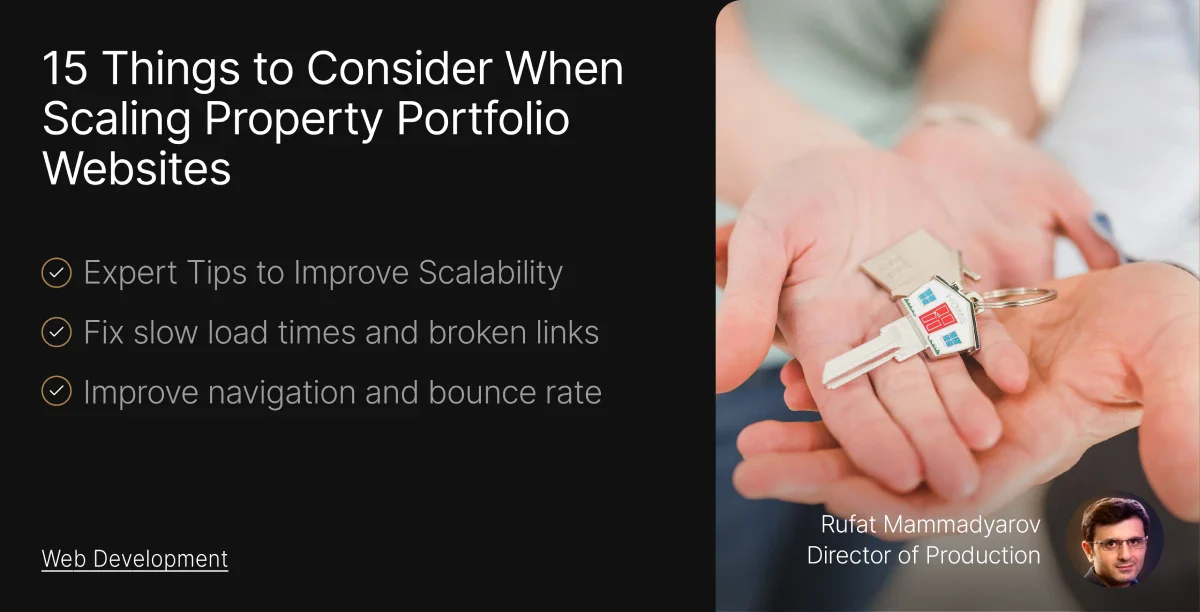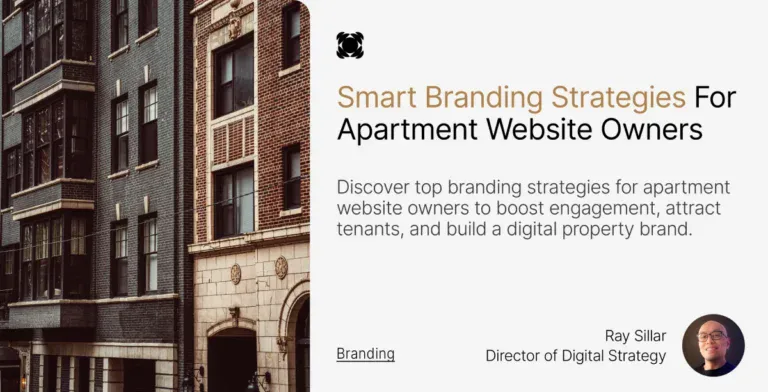Did you know that more than 74% of users are unlikely to return to a website if it’s not mobile-friendly?
This isn’t a statistic that only affects the eCommerce industry; it encompasses all industries and websites alike.

Your property portfolio website should follow a set of rules, especially if you’re planning on scaling it to a bigger and more complex website.
Scaling a property website isn’t just about adding listings and making your property descriptions sound better; it’s more about creating a website that improves visibility, credibility, and efficiency.
This article will cover 15 of the most essential points to consider when planning to scale your property portfolio website.
Trying to improve your property website but don’t know where to start? Let us help.
15 Considerations When Scaling Property Portfolio Websites
This list is in no particular order. Every single point should be taken into consideration and used appropriately if possible.
Make sure to take notes and double-check if your property portfolio website could benefit from any of these considerations.
1. Website Architecture and Scalability
A property portfolio website should be built on a proper foundation on which it can grow.
If you lay the wrong foundations, then it will become a real issue once you start scaling your website up and trying to incorporate more complex systems.
Poor architecture can and will affect your portfolio website’s performance, especially if there is a big stream of visitors going to your website.
With bad architecture, bottlenecks are very common, which can make visitors leave due to pages taking too long to load.
To avoid these issues, make sure you create your property portfolio website with a good CMS, such as WordPress.
Also, consider scaling in a modular fashion; this way, features can be added to your property portfolio website without breaking anything.
A fully scalable architecture will ensure that regardless of how much your portfolio grows, your website performance won’t suffer at all.
2. Mobile Responsiveness
When more than 60% of web traffic is entirely from mobile devices, it’s a no-brainer to have a website that looks good regardless of screen size.
If your property portfolio website doesn’t adapt to different screens automatically, then you’ll lose valuable leads in seconds.
Creating a website with mobile-friendliness in mind is a must if you want to thrive nowadays. Make sure your website not only looks good on mobile, but that it functions properly, too.
Double-check that the buttons are easy to click and that the dropdown menus don’t cover the whole screen.
You can ensure proper mobile-friendliness by using different mobile devices and browsers to see if there is anything that needs tweaking.
3. Speed Optimization
Nothing deters visitors from exploring a website more than slow-loading pages. Visitors expect all of the pages in your property portfolio website to load under 3 seconds.
If you want to check whether your property portfolio website is loading slowly or not, you can use Pagespeed Insights and adjust your website accordingly.
Here are some tips to optimize your website for faster loading times:
- Compress your images and use a format like WebP for minimal loss of quality.
- Use Content Delivery Networks (CDNs) for better global reach and speed.
- Choose a high-quality and reputable hosting provider that can handle high-traffic websites.
- Enable caching and minify CSS/JS files.
Scaling a property portfolio website means that you will add more listings, more images, and more data.
This means that ensuring your website runs fast, regardless of the extra content, is necessary.
4. SEO and Local Optimization
Scaling your website isn’t only about technical growth; it’s also about your visibility and reach.
What’s the point of making an amazing-looking website if no one can see it?
A properly researched and optimized property portfolio website ensures that all of your property listings are discoverable and easy to find.
- When creating your pages, use targeted keywords that relate to the location of your property and what it offers.
- Optimize your website for local SEO by creating a Google Business Profile, ensuring NAP consistency, and building local backlinks.
- Try to publish articles about interesting activities people can do near your properties. This gives potential renters more insight into what is nearby and boosts your website’s authority.
Working on your propertywebsite’s SEO strategy is a must for any business trying to grow organically.
5. Advanced Search and Advanced Filters
The more your property portfolio grows, the harder it becomes for visitors to find the exact property they are looking for manually.
This means that your website should integrate features that make it easier for them to find what they are looking for as quickly as possible.
A great search and filtering system should be able to find exactly what users are looking for with minimal effort. It should be able to filter by price, size, location, amenities, availability, and more.
You can even add map integrations such as Google Maps or Mapbox if you want to add an extra layer of convenience for your potential customers.
Intuitive search features ensure that any visitor can find what they are looking for without feeling overwhelmed by all the options available.
6. Scalable Database Management
A property portfolio website needs a strong database management system, especially if it receives thousands of entries every week.
A weak database system that can’t handle the queries needed can potentially lead to errors, data loss, or even downtime.
Make sure your website uses relational databases, such as MySQL or PostgreSQL, for optimized scalability.
Double-check that you’re caching layers for faster property retrieval and double-check that you’re backing up data on a regular basis just in case something goes wrong.
Having a scalable database management system can save you a lot of trouble in the long run and is the backbone of every successful property website.
7. Property Management System (PMS) Integration
Scaling your website isn’t only about the frontend; it’s also about backend efficiency.
By integrating your website with a PMS, you can streamline a lot of workflows that you would otherwise have to do manually.
Some of the best features you get from a PMS are:
- Your website can automatically sync property availability instantly.
- You can manage both tenant applications and inquiries all from one customizable dashboard.
- Full automation of lease renewals and reminders.
The more properties you start managing, the more important it is to automate and have full system integrations.
Not only will it save you time and money every week, but it will ensure that no one makes mistakes.
8. CRM and Lead Nurturing Tools
Having a Customer Relationship Management (CRM) system can significantly improve how you handle inquiries every day.
As your property portfolio website grows, so does the number of unique inquiries.
A strong CRM ensures that your property portfolio website converts traffic into clients with less overall effort on your part.
We recommend using CRMs such as HubSpot or Salesforce for the best bang for your buck.
Both let you track user behavior, automate follow-ups, segment leads by buyer intent, location, and even property type.
This gives you a lot of customization options to target every single type of potential customer out there.
9. Security and Compliance
As your listings, users, and transactions grow, the more likely you are to face cybersecurity threats.
This means that taking every measure to protect your website and your customers’ information is a must.
Here are some security measures that you should take into account right now.
- Implement SSL certificates across every single page of your website.
- Use multi-factor authentication for all of your admin logins.
- Stay on top of updates for your plugins, themes, and server software.
- Double-check that you’re compliant with GDPR and local data privacy laws.
Make sure you have all of your security measures in place even before you start scaling your property portfolio website.
The last thing you want is for a security breach to happen due to a lack of proper security measures.
10. Content Strategy
Scaling your website also means that you have to build your authority as a property business. Creating content for your property portfolio website should start to become at least a bi-weekly occurrence.
High-quality content shows your visitors that you’re trustworthy and that they should have nothing to worry about when looking at properties you own.

There are hundreds, if not thousands, of different topics you can talk about when it comes to properties, but here are some good ideas to get you started.
- Create multiple neighborhood and market trends reports that tailor to your specific customer personas.
- Highlight success stories and testimonials from past investors and tenants who have worked with you.
- Make use of video tours so that your properties stand out. Extra points if you provide them with 3D virtual tours where they can move the camera around.
- Post regular property investment guides and tips for first-time investors.
Content marketing ensures that your growing portfolio is backed up by knowledge that is free for anyone to view.
11. Branding Consistency
This is a part that is usually not talked about when brands want to scale their website. Maintaining consistent branding when scaling your property portfolio website is vital if you want to maintain credibility and a professional image.
If you want to make sure your branding is consistent, there are several things you can do before scaling your website.
You can create a branded listing template so it’s the same every single time you create a new page. You can use a design system for color palettes, imagery, and even typography. This makes it hard to use the wrong things when creating a new page.
And last but not least, you should always double-check all of your property descriptions to know if your brand voice is consistent.
A consistent design enhances recognition and improves trust as your portfolio grows.
12. Analytics and Performance Tracking
When scaling your property portfolio website, you need metrics to know if the investment has been worthwhile or not. Without any type of analytics, you’re basically doing work with a blindfold on.
Make sure you are using either Google Analytics or an alternative such as Mixpanel.
Then focus on the metrics that truly matter for property websites, such as inquiries, bounce rates, conversion rates, and traffic sources.
If you want to take a step further and optimize your property website even more, you can use website heatmap apps such as the ones from HotJar or Microsoft Clarity.
With this, you can tweak your website based on where visitors spend the most time and leverage specific templates.
13. Automation and Efficiency
The bigger your property portfolio gets, the more work you need to maintain it.
This means that unless you have the time to do all of that manual labor, it’s best to find automated systems that help you with daily tasks.
Automating email confirmations for inquiries is a must as your website traffic grows.
Using chatbots for FAQs and simple questions is a great way to reduce the time spent on customer service.
Workflow automation tools such as Zapier can also help smooth out different tasks by syncing data across multiple platforms.
Automation will only keep getting better as time goes on, so the faster you get used to these systems, the better.
14. Marketing Campaigns
A larger property portfolio means more marketing campaigns to work on, but it also means a lot more competition.
If you’re planning on scaling your property portfolio website, then you should prepare in-depth digital marketing strategies to help push your listings.
- Run paid ads on Google and social platforms that target your customer personas.
- Build segmented email campaigns to show the ideal listings to your different customers.
- Collaborate with other accounts in the property investment space to reach a broader audience.
A well-thought-out digital marketing plan ensures that website scalability matches business growth.
15. Future Proofing with AI
AI is not just for chatbots anymore; every year there are more AI tools that help property businesses adapt to new trends.
AI search bars can help visitors by recommending properties to them based on their past searches and filters used. Virtual Reality (VR) tours are slowly becoming popular as more people get used to VR in general.
AI is going nowhere; in fact, AI will continue to integrate itself into websites and daily applications as we move forward.
Get a Custom Property Portfolio Website that Converts with Blacksmith
After going through our top 15 things to consider before scaling property portfolio websites, it is clear that applying all of this requires a lot of time and effort.
This is time you could be using for other aspects of your property business. So what now?
That’s where we come in. Blacksmith is a premium web development company with seasoned web developers ready to optimize and scale your property portfolio website to a whole new level.
From creating a proper SEO strategy to integrating the latest AI tools around, we will ensure that your website stands out from the competition and thrives.
Still unsure if investing in a custom property portfolio website is the way to go? Don’t worry, click here to schedule a call with us and we’ll audit your current website from top to bottom. This way, we can show you all of the areas where you are missing out on potential leads and what we can do to fix them.









